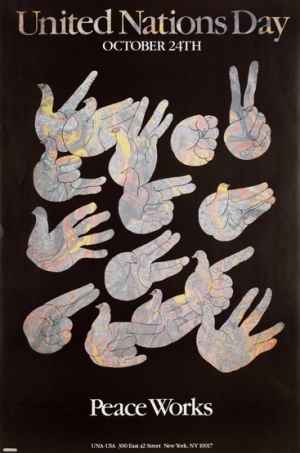The Art of Milton Glaser: To Inform and Delight
“The purpose of art is to inform and delight” [1] is the response Milton Glaser gave regarding his artistic intentions. Glaser’s art is highly successful and acclaimed due to his attempts to inform and delight. Throughout his career, Glaser has been prolific in creating various forms of graphic art. As a result, Glaser’s iconic works are renowned. Wherever it is the I Love New York slogan or The Nation Initiative Buttons, Glaser knows how to gain people’s attention. Stephen Holden states “the hallmark of his work are its simplicity” [2], giving credence to Glaser’s art transcending upon everyone.
Music within Glaser’s Art

Glaser’s art in music-related projects reflects a musician’s vibrancy upon their fans. Dylan is a promotional poster coinciding with Bob Dylan’s 1967 Greatest Hits album. Dylan aims to represent what Dylan’s music means to his fans. Dylan in its use of color and composition creates vibrancy. Dylan‘s silhouetted figure strongly contrasts with the blend of colors on his head. The blended colors create vibrancy as they reflect Dylan’s music to his fans, considering his status as an innovative musician. Even if people are unfamiliar with Dylan’s music, the composition can engage them towards Dylan’s creativity. Glaser’s vibrant style is not only evident in Dylan but it also evokes the 1960s counter-culture, where Dylan’s creativity and innovation is part of the decade’s progressive nature.

Glaser’s idea of graphic art aiming to inform and delight is reflected again in Elvis, which is the front cover of Albert Goldman’s 1979 biography. Glaser recreates an image of a youthful Elvis, whose light blue eyes engage people into experiencing an intensity which led to legions of female fans. Glaser’s artistic intention for Elvis shows the acclaimed rock n’ roll singer at his youthful peak, which is where Elvis fans have their fondest memories. Elvis’ range of colors are soft on the eye, creating an angelic representation. Elvis being the front cover of a biography is an effective prelude to Elvis’ tragic decline. The further a reader is informed on Elvis’ life, the front cover will serve as a powerful indication of what Elvis was and what he lost in life.
Society within Glaser’s Art

Glaser’s artistic work coinciding with social issues results in great significance. The most iconic is I Love New York. New York City in the 1970s was in disarray, therefore the local authorities wanted to promote a positive image. Former New York police commissioner Robert McGuire felt the city during the 1970s was horrific. “We had a city out of control. It was the wild west” [3]. I Love New York is Glaser’s response to New York citizens, wanting them to become united rather than divided. I Love New York can be seen as a catalyst which began building better community relations in New York. Glaser’s design has greater appeal post 9/11, when Glaser reworked the I Love New York logo in I Love New York More Than Ever. Glaser’s reworking extends his ideal of informing New York citizens to unite against societies’ evils, symbolised by the black mark on the heart. The black mark acts as a catalyst for the poster’s message, that New York citizens are strong enough to prevail.

It’s Not Warming, It’s Dying is another direct engagement from Glaser to promote social unity. The wording is direct in its use of dying, indicating that there is little time to solve environmental issues. Therefore it is meant to influence people to take action. Glaser’s choice of imagery is equally effective. Planet Earth as a dark green ball slowly turning black continues to indicate time is short.

Politics in Glaser’s Art

Glaser’s art calling for social unity has also become prominent in promoting political messages. The Nation Initiative Buttons became popular during the Iraq war outrage as its messages echoed public sentiment. Glaser’s use of color and wording coincides to create instantaneous connotations to the button’s political standpoint. The black button signifying oil with “WAR” states underlying truths from Glaser’s perspective regarding the Iraq war, and the “Preemptive WAR Is Terrorism” uses red, symbolic of blood, as the background. Glaser’s use of color reflects a direct approach to spread political messages. United Nations Day Peace Works promotes intentions for global unity. Glaser’s use of black within United Nations Day Peace Works is an effective way to emphasise the main image. The main image, a series of hands imitating doves, has deep symbolic meanings. Doves have traditionally been symbols of peace. Human hands imitating doves sends a message that all societies can make the world a peaceful place.

Glaser’s graphic art evokes messages and representations in a direct manner, affecting everyone. Glaser describes his artistic intentions as to inform and delight. These qualities are contained in directing Glaser’s intentions amusingly, such as the joy within I Love New York or spark people’s thoughts on current issues like The Nation Initiative Buttons. Glaser’s use of vibrant colors and composition along with his direct messages results in people understanding and enjoying Glaser’s graphic art. Glaser’s repetitive use of these aspects within his graphic art reinforces the transcendent qualities that people can understand.
Works Cited
1. Milton Glaser: To Inform and Delight. 2008. Dir. Wendy Keys. Checkerboard Foundation.
2. Anonymous. 2009. ‘Milton Glaser’. TED.COM. [Online][Available From] – https://www.ted.com/speakers/milton_glaser
3. Anonymous. 2011. ‘Milton Glaser: His Heart Was In The Right Place’. The Guardian. [Online][Available From] – http://www.telegraph.co.uk/culture/art/art-features/8303867/Milton-Glaser-his-heart-was-in-the-right-place.html
What do you think? Leave a comment.











A simple but effective designer.
“Milton Glaser: To Inform and Delight” is a great documentary to watch for the fans.
It was watching the documentary which influenced me to write this article.
This man does not need to excuse himself for achieving everything- Amazing!
Amazing man, thanks for the post.
Thank you Jonas
I was not familiar with him before. Thanks for writing about him and his work.
What’s great is he is very vocal about current design principles and trends.
He is a genius.
My completely unbiased opinion as an SVA alum.
Glaser is so brilliant.
If you are a designer, you realize the great ideas he presents. If your just a consumer, you wont.
why are there no books, essays on his philosophy of life. Nor a TED talk. I would love to have worked for him.
Milton is magnificent.
I cannot get enough of Milton Glaser! Thank you for this.
Milton Glaser is always a pleasure to learn from.
It’s a good intro to an artist I haven’t heard of. Nice!
Nice article. Years ago I curated an exhibit of Milton Glaser’s art, and for reasons I won’t go into, had the original Bob Dylan artwork stored in my basement for an evening. That night I woke up and thought, “My gosh, Milton Glaser’s original Dylan portrait is in my basement!” This was quickly followed by, “I hope the plumbing doesn’t leak.”
Nice to know that Glaser created the I heart NY design and how it came about.
what do people think of Milton Glaser work?